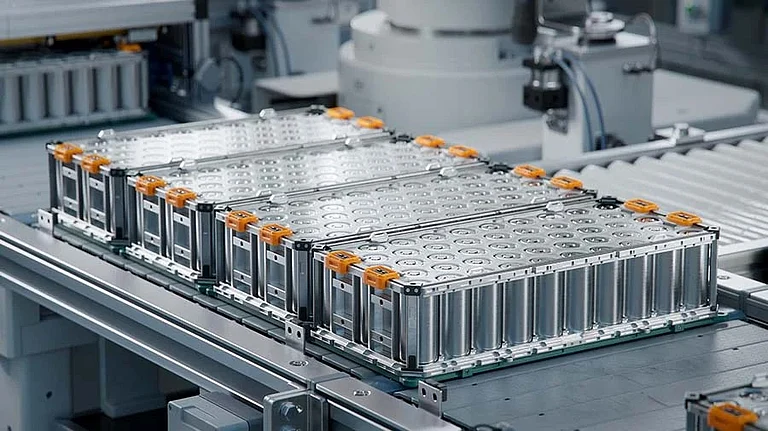The production-linked incentive (PLI) scheme for solar photovoltaic (PV) manufacturing in India, aimed at boosting domestic production and reducing import reliance, has shown progress but also faces several operational challenges.
The total budget of ₹24,000 crore is divided into two tranches with the objective of establishing gigawatt (GW) scale domestic manufacturing. The first tranche involves 10GW of capacity with 8,737 megawatt (MW) fully integrated manufacturing units approved, with the financial outlay of ₹4,500 crore allocated for the scheme.
Around ₹19,500 crore allocated in the second tranche may potentially help attract an investment of ₹93,000 crore. It targets 39,600MW in three phases: 7,400MW by October 2024, 16,800MW by April 2025 and 15,400MW by April 2026.
Boon or Bane?
However, the PLI scheme presents a number of flaws and limitations based on available data.
First, the scheme favors vertically integrated large firms, sidelining MSMEs. They’re often ineligible due to scale, integration and efficiency requirements. Without incentives, many smaller domestic manufacturers (200–500MW capacity) may be unable to compete, risking 40–50% closures.
The second limitation relates to inadequate budget and disbursement issues. The initial budget was ₹4,500 crore ($600mn) but later increased to ₹24,000 crore; still insufficient to build truly competitive capacity. Across all PLI sectors, only 2% of incentive outlay has been disbursed; solar remains among the sluggish performers.
Then there are the disappointing performance metrics. India’s PLI across all sectors has hit only 37% of production targets as of October 2024. In the solar PV segment, eight out of 12 participating firms (e.g., Reliance, Adani, JSW) are unlikely to meet their targets. The PLI scheme encourages high efficiency modules. But Indian manufactures face stiff competition from low-cost Chinese imports that dominate the global markets. The scheme doesn’t address the R&D or quality competitiveness issues.
Further, requirements for steep incremental sales, domestic value-addition and vertical integration raise the entry threshold, discouraging smaller players. Lags in approvals and complex paperwork also slow down implementation. Import barriers, such as basic custom duty (BCD) and approved list of models and manufacturers (ALMM) aim to protect domestic players. But this increases project costs and slows down solar deployment, especially for developers who are caught in transition.
Large-scale manufacturing requires energy, land and water. Approvals and infrastructure support are still catching up. Manufacturers still rely heavily on imported components—solar glass, EVA, frames—since these aren’t incentivised. Over 56% of modules and 65 % cells are still imported, and one manufacturing company reported that out of 94 vendors, 67 were Chinese.
PLI increases module costs in the initial stages by 6%, funded by taxpayers. Utilities passing these on have breached ₹3 per kilowatt-hour, making solar less competitive versus coal. There are unclear long-term demand signals. Government tenders largely fulfill domestic demand. But in many instances these tenders get delayed or even cancelled. This directly influences the manufacturer’s commitment to large capacity expansion
Finally, high capital costs, expensive electricity, low utilisation and skill shortages persist—factors PLI alone can't fix. Lack of centralised performance monitoring makes it hard to evaluate value-addition, job creation or export impact.
Course Correction
The government must broaden MSME participation by launching PLI 2.0 for smaller manufacturers and component suppliers. There should be cluster-based incentives in solar parks or industrial zones. To support innovations in R&D there is need to create a National Solar Innovation Mission with tax incentives, grants for R&D and academia-industry partnerships.
There is need to ensure raw material security by incentivising domestic polysilicon and wafer production separately. Indian manufacturers must explore international tie-ups or joint ventures for tech transfer in upstream manufacturing. A single-window clearance system for land, environment and utility connections will help ease-of-doing-business.
The government will at some point of time have to streamline GST/tax issues across the supply chain. There is a need to stabilise the demand pipeline to ensure consistent solar tenders from the Solar Energy Corporation of India, National Thermal Power Corporation and state discoms. Minimum purchase guarantees for domestic modules must be introduced.
The PLI scheme is a powerful tool to build India’s solar manufacturing base, but its success depends on faster execution, ecosystem development for raw material, R&D and testing. There must be balancing of large-scale investments with MSME inclusion with clear policy signals and procurement stability.
The writer is an energy-transition professional and adviser



























